#agile performance testing methodology
Explore tagged Tumblr posts
Text

Embark on a global bug hunt with our SDET team, leveraging cloud-based mobile testing to ensure your app achieves flawless performance across all devices and networks. With cutting-edge tools and a meticulous approach, we identify and eliminate bugs before they impact your users. https://rb.gy/jfueow #SDET #BugHunt #CloudTesting #MobileAppQuality #FlawlessPerformance SDET Tech Pvt. Ltd.
#Software Testing Companies in India#Software Testing Services in India#Test Automation Development Services#Test Automation Services#Performance testing services#Load testing services#Performance and Load Testing Services#Software Performance Testing Services#Functional Testing Services#Globalization Testing services#Globalization Testing Company#Accessibility testing services
Agile Testing Services#Mobile Testing Services#Mobile Apps Testing Services#ecommerce performance testing#ecommerce load testing#load and performance testing services#performance testing solutions#product performance testing#application performance testing services#software testing startups#benefits of load testing#agile performance testing methodology#agile testing solutions#mobile testing challenges#cloud based mobile testing#automated mobile testing#performance engineering & testing services#performance testing company#performance testing company in usa
0 notes
Text
Automated Testing vs. Manual Testing: Which One is Right for Your Project?
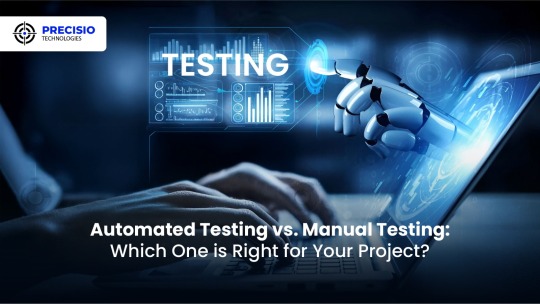
Achieving high-quality, reliable software stands as a fundamental requirement in software development. Successful testing functions as an essential tool to discover faults and build performance capabilities that create better user experience outcomes. Two main testing methods dominate the field: automated testing and manual testing. The process of quality software assurance uses different testing approaches that demonstrate their own advantages as well as weaknesses according to specific project requirements and scenarios. We will explore the specifics to determine which testing process works best for your system development efforts.
1. What Is Manual Testing?

Manual testing involves a human tester manually executing test cases without using automation tools. Key Characteristics:
The methodology focuses its efforts on user interface together with usability and experience testing.
Human-centered applications where selection requires discretion include ad hoc testing and enumerative testing as well as examinations that need human evaluation.
Human performers are required during this approach; thus, it demands substantial time.
2. What Is Automated Testing?
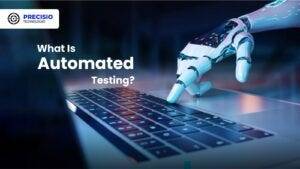
Software performing automated testing executes test cases through workflows and helpers. Key Characteristics:
Efficient for repetitive and regression testing.
Users must spend money on tools along with developing custom scripts for testing.
Reduces human error.
3. Advantages of Manual Testing

Human Intuition: Software testing professionals can detect kernels through their human cognitive ability that automated tools cannot match. The observation and evaluation of visual elements runs more efficiently through human operatives instead of advanced tools.
Flexibility: This method suits exploratory testing specifically because there are no pre-determined scripts available.
Low Initial Investment: Running this approach does not need tool purchases or applications to develop automation frameworks.
Adaptable for UI/UX Testing: Running this approach does not need tool purchases or applications to develop automation frameworks.
4. Advantages of Automated Testing
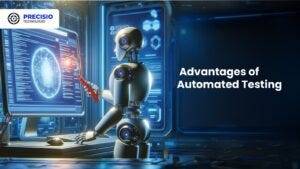
Speed: Executes repetitive tests much faster than humans.
Scalability: The system proves most effective for extensive projects that need constant system updates.
Accuracy: When performing recurring actions, automated systems minimize the chances of human mistakes.
Cost-Efficient in the Long Run: Once established and implemented, the system demands costly investments but ensures continuous development expenses decrease over time.
Better for CI/CD Pipelines: Such testing technology connects various development pipelines that support agile and DevOps methodologies.
5. Disadvantages of Manual Testing

Time-Consuming: The manual performance of repeated tests leads to delayed completion of projects.
Error-Prone: Large applications contain tiny bugs that human testers commonly fail to detect.
Not Ideal for Scalability: The process of increasing manual testing needs additional testers to avoid cost escalations.
6. Disadvantages of Automated Testing
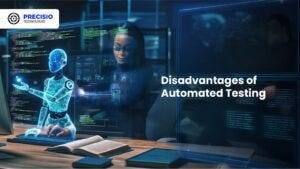
Initial Costs: Organizations must provide high financial resources to procure testing tools together with developing programming constructs.
Limited to Pre-Defined Scenarios: These testing approaches work poorly for handling exploratory or ad hoc testing.
Requires Maintenance: Test scripts need frequent updates when application changes occur.
Not Suitable for UI/UX Testing: Struggles with subjective user experience evaluations.
7. When to Use Manual Testing
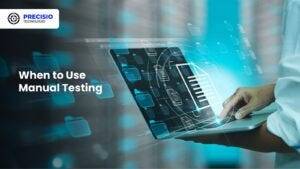
Small Projects: The testing method proves beneficial at a low cost for small applications and provides quick assessments.
Exploratory Testing: Testing this approach benefits projects whose scripts have not been defined yet or need evaluation for newly added features.
Visual and Usability Testing: Performing assessments on interface components together with design features.
8. When to Use Automated Testing
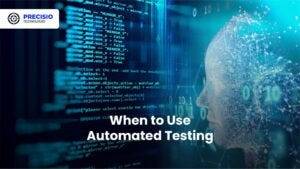
Large Projects: Handles scalability for projects with frequent updates.
Regression Testing: Program testing becomes more efficient through automation since automated assessments perform multiple tests following each update process.
Performance Testing: The system performs efficient capabilities to conduct load testing and stress testing.
Continuous Development Environments: Agile progression and DevOps implementations need automation as a core requirement.
READ MORE- https://www.precisio.tech/automated-testing-vs-manual-testing-which-one-is-right-for-your-project/
2 notes
·
View notes
Text
How-To IT
Topic: Core areas of IT
1. Hardware
• Computers (Desktops, Laptops, Workstations)
• Servers and Data Centers
• Networking Devices (Routers, Switches, Modems)
• Storage Devices (HDDs, SSDs, NAS)
• Peripheral Devices (Printers, Scanners, Monitors)
2. Software
• Operating Systems (Windows, Linux, macOS)
• Application Software (Office Suites, ERP, CRM)
• Development Software (IDEs, Code Libraries, APIs)
• Middleware (Integration Tools)
• Security Software (Antivirus, Firewalls, SIEM)
3. Networking and Telecommunications
• LAN/WAN Infrastructure
• Wireless Networking (Wi-Fi, 5G)
• VPNs (Virtual Private Networks)
• Communication Systems (VoIP, Email Servers)
• Internet Services
4. Data Management
• Databases (SQL, NoSQL)
• Data Warehousing
• Big Data Technologies (Hadoop, Spark)
• Backup and Recovery Systems
• Data Integration Tools
5. Cybersecurity
• Network Security
• Endpoint Protection
• Identity and Access Management (IAM)
• Threat Detection and Incident Response
• Encryption and Data Privacy
6. Software Development
• Front-End Development (UI/UX Design)
• Back-End Development
• DevOps and CI/CD Pipelines
• Mobile App Development
• Cloud-Native Development
7. Cloud Computing
• Infrastructure as a Service (IaaS)
• Platform as a Service (PaaS)
• Software as a Service (SaaS)
• Serverless Computing
• Cloud Storage and Management
8. IT Support and Services
• Help Desk Support
• IT Service Management (ITSM)
• System Administration
• Hardware and Software Troubleshooting
• End-User Training
9. Artificial Intelligence and Machine Learning
• AI Algorithms and Frameworks
• Natural Language Processing (NLP)
• Computer Vision
• Robotics
• Predictive Analytics
10. Business Intelligence and Analytics
• Reporting Tools (Tableau, Power BI)
• Data Visualization
• Business Analytics Platforms
• Predictive Modeling
11. Internet of Things (IoT)
• IoT Devices and Sensors
• IoT Platforms
• Edge Computing
• Smart Systems (Homes, Cities, Vehicles)
12. Enterprise Systems
• Enterprise Resource Planning (ERP)
• Customer Relationship Management (CRM)
• Human Resource Management Systems (HRMS)
• Supply Chain Management Systems
13. IT Governance and Compliance
• ITIL (Information Technology Infrastructure Library)
• COBIT (Control Objectives for Information Technologies)
• ISO/IEC Standards
• Regulatory Compliance (GDPR, HIPAA, SOX)
14. Emerging Technologies
• Blockchain
• Quantum Computing
• Augmented Reality (AR) and Virtual Reality (VR)
• 3D Printing
• Digital Twins
15. IT Project Management
• Agile, Scrum, and Kanban
• Waterfall Methodology
• Resource Allocation
• Risk Management
16. IT Infrastructure
• Data Centers
• Virtualization (VMware, Hyper-V)
• Disaster Recovery Planning
• Load Balancing
17. IT Education and Certifications
• Vendor Certifications (Microsoft, Cisco, AWS)
• Training and Development Programs
• Online Learning Platforms
18. IT Operations and Monitoring
• Performance Monitoring (APM, Network Monitoring)
• IT Asset Management
• Event and Incident Management
19. Software Testing
• Manual Testing: Human testers evaluate software by executing test cases without using automation tools.
• Automated Testing: Use of testing tools (e.g., Selenium, JUnit) to run automated scripts and check software behavior.
• Functional Testing: Validating that the software performs its intended functions.
• Non-Functional Testing: Assessing non-functional aspects such as performance, usability, and security.
• Unit Testing: Testing individual components or units of code for correctness.
• Integration Testing: Ensuring that different modules or systems work together as expected.
• System Testing: Verifying the complete software system’s behavior against requirements.
• Acceptance Testing: Conducting tests to confirm that the software meets business requirements (including UAT - User Acceptance Testing).
• Regression Testing: Ensuring that new changes or features do not negatively affect existing functionalities.
• Performance Testing: Testing software performance under various conditions (load, stress, scalability).
• Security Testing: Identifying vulnerabilities and assessing the software’s ability to protect data.
• Compatibility Testing: Ensuring the software works on different operating systems, browsers, or devices.
• Continuous Testing: Integrating testing into the development lifecycle to provide quick feedback and minimize bugs.
• Test Automation Frameworks: Tools and structures used to automate testing processes (e.g., TestNG, Appium).
19. VoIP (Voice over IP)
VoIP Protocols & Standards
• SIP (Session Initiation Protocol)
• H.323
• RTP (Real-Time Transport Protocol)
• MGCP (Media Gateway Control Protocol)
VoIP Hardware
• IP Phones (Desk Phones, Mobile Clients)
• VoIP Gateways
• Analog Telephone Adapters (ATAs)
• VoIP Servers
• Network Switches/ Routers for VoIP
VoIP Software
• Softphones (e.g., Zoiper, X-Lite)
• PBX (Private Branch Exchange) Systems
• VoIP Management Software
• Call Center Solutions (e.g., Asterisk, 3CX)
VoIP Network Infrastructure
• Quality of Service (QoS) Configuration
• VPNs (Virtual Private Networks) for VoIP
• VoIP Traffic Shaping & Bandwidth Management
• Firewall and Security Configurations for VoIP
• Network Monitoring & Optimization Tools
VoIP Security
• Encryption (SRTP, TLS)
• Authentication and Authorization
• Firewall & Intrusion Detection Systems
• VoIP Fraud DetectionVoIP Providers
• Hosted VoIP Services (e.g., RingCentral, Vonage)
• SIP Trunking Providers
• PBX Hosting & Managed Services
VoIP Quality and Testing
• Call Quality Monitoring
• Latency, Jitter, and Packet Loss Testing
• VoIP Performance Metrics and Reporting Tools
• User Acceptance Testing (UAT) for VoIP Systems
Integration with Other Systems
• CRM Integration (e.g., Salesforce with VoIP)
• Unified Communications (UC) Solutions
• Contact Center Integration
• Email, Chat, and Video Communication Integration
2 notes
·
View notes
Text
Azure DevOps Training
Azure DevOps Training Programs

In today's rapidly evolving tech landscape, mastering Azure DevOps has become indispensable for organizations aiming to streamline their software development and delivery processes. As businesses increasingly migrate their operations to the cloud, the demand for skilled professionals proficient in Azure DevOps continues to soar. In this comprehensive guide, we'll delve into the significance of Azure DevOps training and explore the myriad benefits it offers to both individuals and enterprises.
Understanding Azure DevOps:
Before we delve into the realm of Azure DevOps training, let's first grasp the essence of Azure DevOps itself. Azure DevOps is a robust suite of tools offered by Microsoft Azure that facilitates collaboration, automation, and orchestration across the entire software development lifecycle. From planning and coding to building, testing, and deployment, Azure DevOps provides a unified platform for managing and executing diverse DevOps tasks seamlessly.
Why Azure DevOps Training Matters:
With Azure DevOps emerging as the cornerstone of modern DevOps practices, acquiring proficiency in this domain has become imperative for IT professionals seeking to stay ahead of the curve. Azure DevOps training equips individuals with the knowledge and skills necessary to leverage Microsoft Azure's suite of tools effectively. Whether you're a developer, IT administrator, or project manager, undergoing Azure DevOps training can significantly enhance your career prospects and empower you to drive innovation within your organization.
Key Components of Azure DevOps Training Programs:
Azure DevOps training programs are meticulously designed to cover a wide array of topics essential for mastering the intricacies of Azure DevOps. From basic concepts to advanced techniques, these programs encompass the following key components:
Azure DevOps Fundamentals: An in-depth introduction to Azure DevOps, including its core features, functionalities, and architecture.
Agile Methodologies: Understanding Agile principles and practices, and how they align with Azure DevOps for efficient project management and delivery.
Continuous Integration (CI): Learning to automate the process of integrating code changes into a shared repository, thereby enabling early detection of defects and ensuring software quality.
Continuous Deployment (CD): Exploring the principles of continuous deployment and mastering techniques for automating the deployment of applications to production environments.
Azure Pipelines: Harnessing the power of Azure Pipelines for building, testing, and deploying code across diverse platforms and environments.
Infrastructure as Code (IaC): Leveraging Infrastructure as Code principles to automate the provisioning and management of cloud resources using tools like Azure Resource Manager (ARM) templates.
Monitoring and Logging: Implementing robust monitoring and logging solutions to gain insights into application performance and troubleshoot issues effectively.
Security and Compliance: Understanding best practices for ensuring the security and compliance of Azure DevOps environments, including identity and access management, data protection, and regulatory compliance.
The Benefits of Azure DevOps Certification:
Obtaining Azure DevOps certification not only validates your expertise in Azure DevOps but also serves as a testament to your commitment to continuous learning and professional development. Azure DevOps certifications offered by Microsoft Azure are recognized globally and can open doors to exciting career opportunities in various domains, including cloud computing, software development, and DevOps engineering.
Conclusion:
In conclusion, Azure DevOps training is indispensable for IT professionals looking to enhance their skills and stay relevant in today's dynamic tech landscape. By undergoing comprehensive Azure DevOps training programs and obtaining relevant certifications, individuals can unlock a world of opportunities and propel their careers to new heights. Whether you're aiming to streamline your organization's software delivery processes or embark on a rewarding career journey, mastering Azure DevOps is undoubtedly a game-changer. So why wait? Start your Azure DevOps training journey today and pave the way for a brighter tomorrow.
5 notes
·
View notes
Text
Key Project Management Strategies for Market Research Professionals

In the dynamic and data-driven world of market research, effective project management is crucial for delivering insightful and actionable results. Market research professionals must navigate various stages of research projects, from initial planning to data collection, analysis, and reporting. Implementing sound project management principles can ensure these projects are completed on time, within budget, and to the highest quality standards. This article explores key project management principles tailored for market research professionals.
1. Define Clear Objectives and Scope
Setting the Stage for Success
Before diving into a market research project, it's essential to define clear objectives and scope. What are the research questions you aim to answer? What are the specific goals of the study? Establishing these parameters upfront helps to maintain focus and ensures that all stakeholders have a shared understanding of the project’s purpose.
Scope Management
Scope management involves identifying all the work required to complete the project successfully and ensuring that only the necessary tasks are included. This prevents scope creep, which can lead to project delays and cost overruns.
2. Develop a Detailed Project Plan
Roadmap to Completion
A comprehensive project plan serves as a roadmap for the entire project. It should outline key milestones, deliverables, timelines, and resources needed. For market research projects, this might include phases such as survey design, data collection, data analysis, and report generation.
Risk Management
Incorporate risk management strategies into your project plan. Identify potential risks, assess their impact, and develop mitigation plans. This proactive approach helps in managing uncertainties and ensures smoother project execution.
3. Allocate Resources Effectively
Team and Tools
Successful market research projects require the right mix of skills and tools. Assign roles and responsibilities to team members based on their expertise. Ensure that the team has access to necessary tools, such as survey software, data analysis programs, and reporting tools.
Budget Management
Keep a close eye on the project budget. Track expenditures against the budgeted amounts and adjust as necessary. Effective budget management ensures that the project remains financially viable and resources are used efficiently.
4. Implement Strong Communication Channels
Stakeholder Engagement
Regular communication with stakeholders is vital. This includes clients, team members, and other relevant parties. Set up regular meetings, updates, and feedback sessions to keep everyone informed and engaged.
Documentation
Maintain thorough documentation throughout the project. This includes meeting minutes, progress reports, and changes to the project plan. Good documentation provides a clear record of decisions and progress, aiding in transparency and accountability.
5. Monitor and Control the Project
Tracking Progress
Monitoring involves tracking the project’s progress against the plan. Use project management software to help with this. Key performance indicators (KPIs) such as completion rate, adherence to timelines, and budget status can provide insights into project health.
Quality Control
Implement quality control measures to ensure that the research outputs meet the required standards. This can involve peer reviews, data validation checks, and pilot testing survey instruments.
6. Adapt and Iterate
Flexibility in Approach
Market research projects can encounter unexpected changes, such as shifts in market conditions or new client requirements. Being adaptable and willing to iterate on your project plan is crucial. Agile project management methodologies can be particularly useful in allowing for flexibility and continuous improvement.
Feedback Loops
Establish feedback loops where team members can provide input on what’s working and what’s not. This helps in making real-time adjustments and fosters a culture of continuous improvement.
7. Deliver and Reflect
Final Delivery
Ensure that the final deliverables meet the client’s expectations and project objectives. This includes a thorough review of the final report, presentations, and any other deliverables to ensure accuracy and clarity.
Post-Project Review
Conduct a post-project review to evaluate what went well and what could be improved. Gather feedback from the team and stakeholders. Document these insights to inform future projects.
Conclusion
Market research professionals can deliver valuable insights and drive successful outcomes by defining clear objectives, developing detailed plans, allocating resources wisely, maintaining strong communication, monitoring progress, adapting as needed, and reflecting on outcomes. Embracing these principles enhances project success and fosters professional growth and organizational excellence in market research.
To know more: project management service company
survey programming company
3 notes
·
View notes
Text
Embracing DevOps: A Journey Towards Technological Excellence
In the ever-evolving landscape of modern technology, where change is the only constant, DevOps has emerged as a revolutionary force reshaping the very foundations of software development and IT operations. Short for Development and Operations, DevOps represents not just a set of practices, but an all-encompassing cultural shift with far-reaching implications in the digital age.
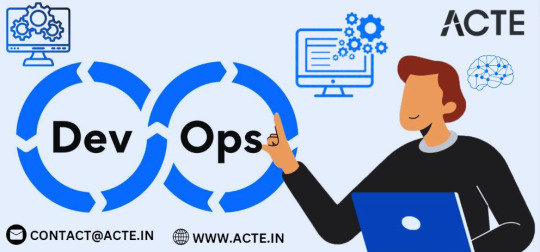
This comprehensive blog invites you to embark on an immersive journey into the expansive universe of DevOps. Here, we dive deep into the multifaceted scope of DevOps and its transformative impact across diverse industries. From turbocharging software delivery to fortifying security and scalability, DevOps isn't just a methodology; it's the cornerstone of success in today's interconnected technological landscape.
Join us as we unravel the boundless possibilities and profound significance of DevOps in the modern tech-driven world.
Unveiling the Multifaceted Scope of DevOps
DevOps isn't a singular concept or a one-size-fits-all approach; it's a dynamic and multifaceted philosophy that touches every facet of modern technology. Let's delve into the various dimensions that collectively define the expansive scope of DevOps:
Streamlined Software Delivery: In a world where time is a valuable currency, DevOps assumes center stage. It empowers organizations to expedite the development, testing, and deployment of software, resulting in swift and efficient software releases, a decisive advantage in today's fast-paced business landscape.
Enhanced Collaboration: DevOps shatters traditional silos that once separated development and operations teams. Instead, it nurtures a culture of collaboration, where every team member works harmoniously toward common objectives, fostering superior outcomes and a culture of relentless innovation.
Continuous Integration and Continuous Delivery (CI/CD): DevOps champions the widespread adoption of CI/CD pipelines, where the process of building, testing, and deploying code becomes an automated symphony. This not only reduces errors but also accelerates the delivery of new features and updates, keeping organizations agile and competitive.
Improved Quality: Quality is the keystone of DevOps. Through automated testing and continuous monitoring, DevOps ensures that software maintains an apex of quality. Issues are pinpointed and rectified early in the development cycle, dramatically lowering the chances of post-production glitches.
Efficient Resource Utilization: DevOps practices become the maestros of resource optimization, eliminating inefficiencies in both time and infrastructure. The result? Cost savings and a more efficient utilization of resources, a double boon for organizations.
Enhanced Security: Security isn't an afterthought in DevOps; it's integrated seamlessly into the very fabric of the process. Automated security scans and checks are an integral part, ensuring proactive measures are taken to minimize vulnerabilities and bolster system security.
Scalability: DevOps, by its very nature, is infinitely scalable. It empowers organizations to seamlessly adjust their operations to meet demand, whether scaling up or down. DevOps ensures that systems can adeptly handle varying workloads, providing the vital elements of flexibility and efficiency.
Monitoring and Feedback: At the core of DevOps lie the principles of continuous monitoring and feedback loops. This guarantees that performance issues are swiftly identified, enabling teams to make necessary adjustments in real-time, further enhancing efficiency.
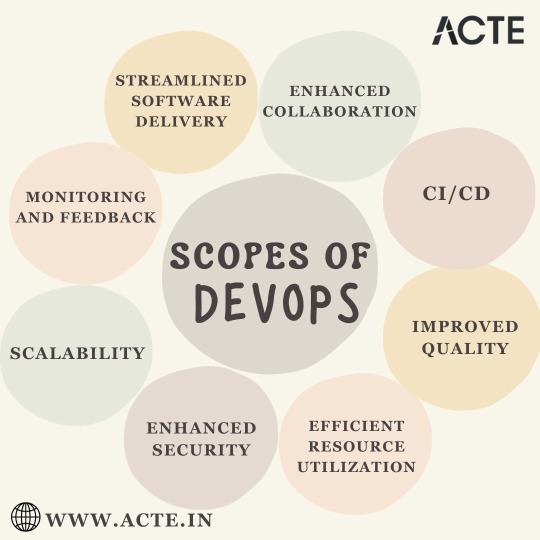
The DevOps Revolution Across Industries:
The scope of DevOps extends beyond the boundaries of industries, leaving its indelible mark in software development, e-commerce, finance, healthcare, and beyond. Its principles and practices are proven to be versatile and adaptable, positioning DevOps as a coveted asset in the world of technology. It drives innovation and efficiency in every sector fortunate enough to embrace it.
In the vast landscape of technology, DevOps has emerged as a beacon of efficiency and innovation. It's not merely a practice; it's a transformative culture that redefines how organizations approach software development and IT operations. With streamlined software delivery, enhanced collaboration, continuous integration and delivery, improved quality, efficient resource utilization, enhanced security, scalability, and vigilant monitoring, DevOps has left an indelible mark across industries.
The scope of DevOps transcends boundaries, impacting software development, e-commerce, finance, healthcare, and beyond. Its principles and practices adapt and evolve, making DevOps an invaluable asset in the world of technology, driving innovation and efficiency wherever it is embraced.
In a world where adaptability and agility are paramount, DevOps shines as an irreplaceable force. And in this dynamic landscape, ACTE Technologies stands as a guiding light, preparing individuals to excel in DevOps. With the rise in demand for skilled DevOps professionals, ACTE Technologies equips learners with the knowledge and practical skills needed to thrive in this dynamic domain. Whether you're a budding DevOps engineer or a seasoned IT professional, embracing DevOps isn't just a career choice; it's a monumental leap towards a promising and impactful future in the tech industry. The possibilities with DevOps are limitless, and the journey ahead is filled with innovation and success.
8 notes
·
View notes
Text
Deciding Between Selenium with Python and Selenium with Java: An In-Depth Comparison
In the domain of automated testing, Selenium emerges as a pivotal tool for ensuring the reliability and quality of web applications. When it comes to selecting the programming language to harness Selenium's capabilities, two prominent contenders often come into play: Python and Java. Both languages offer distinct advantages and considerations, making the decision between them crucial for any automation project.

In this blog post, we'll conduct a thorough comparison of Selenium with Python and Selenium with Java, exploring their unique strengths, use cases, and factors to consider. By the end, readers will have a clearer understanding of which option aligns best with their project requirements, team proficiencies, and organizational objectives.
Python with Selenium:
Python, celebrated for its simplicity and readability, has garnered significant traction within the automation testing community. Let's delve into some key benefits of leveraging Python with Selenium:
Simplicity and Readability: Python's hallmark characteristics include simplicity and readability. Its concise syntax enables developers to express ideas in fewer lines of code, resulting in scripts that are easier to comprehend and maintain. For testers, this translates to expedited development cycles and reduced overhead in managing test suites.
Extensive Ecosystem: Python boasts a vast ecosystem of libraries and frameworks that complement Selenium, augmenting its capabilities for test automation. Whether handling data manipulation, conducting API testing, or generating test reports, Python's rich library support caters to diverse automation needs. Furthermore, the active Python community ensures an abundance of resources, tutorials, and documentation to aid testers throughout the automation journey.
Rapid Prototyping: Python's dynamic nature lends itself well to rapid prototyping and iterative development. Testers can swiftly experiment with different approaches, adapt scripts on-the-go, and respond promptly to evolving requirements. This flexibility seamlessly aligns with agile development methodologies, empowering teams to deliver high-quality software with agility.
Integration Compatibility: Python's interoperability with other tools and technologies makes it an appealing choice for Selenium automation. Whether integrating with continuous integration (CI) pipelines, test reporting frameworks, or version control systems, Python's versatility ensures smooth interoperability, streamlining the testing workflow and bolstering overall efficiency.

Java with Selenium:
Java, renowned for its robustness and performance, has long been a cornerstone in enterprise software development. Here are some compelling reasons to consider Java for Selenium automation:
Robustness and Performance: Java's static typing and strong object-oriented principles contribute to the robustness and performance of Selenium test suites. Its compile-time error checking aids in identifying potential issues early in the development phase, resulting in more stable and reliable automation scripts. For large-scale enterprise projects with stringent quality requirements, Java's reliability is a significant asset.
Widespread Adoption: Java enjoys widespread adoption within the enterprise landscape, making it a natural choice for organizations with existing Java codebases or a Java-centric development environment. The abundance of Java expertise in the workforce, coupled with extensive community support and industry recognition, solidifies its status as a preferred language for Selenium automation in many corporate settings.
Mature Tooling: Java's mature ecosystem of testing tools and frameworks, including JUnit and TestNG, seamlessly integrate with Selenium to offer comprehensive test automation solutions. These frameworks furnish advanced features such as parameterized testing, parallel execution, and built-in reporting capabilities, empowering testers to design and execute sophisticated test suites effortlessly.
Enterprise Support: Java's popularity in enterprise environments translates to robust support from vendors, extensive documentation, and a plethora of third-party integrations. For organizations seeking enterprise-grade features, reliability, and scalability in their Selenium automation endeavors, Java's ecosystem and support infrastructure present a compelling value proposition.
Conclusion:
In summary, both Selenium with Python and Selenium with Java present compelling options for test automation, each with its unique strengths and considerations. Python excels in simplicity, rapid development, and a vast ecosystem, making it an ideal choice for agile teams and projects with evolving requirements. Conversely, Java offers robustness, performance, and widespread enterprise support, rendering it well-suited for large-scale enterprise applications with stringent quality standards.
Ultimately, the decision between Python and Java for Selenium automation hinges on various factors such as project prerequisites, team proficiencies, and organizational preferences. By meticulously evaluating these factors and weighing the pros and cons of each option, stakeholders can make informed decisions that align with their specific needs and aspirations. Whether opting for the simplicity of Python or the robustness of Java, Selenium remains an indispensable tool for driving quality and efficiency in web application testing.
2 notes
·
View notes
Text
Navigating the Full Stack: A Holistic Approach to Web Development Mastery
Introduction: In the ever-evolving world of web development, full stack developers are the architects behind the seamless integration of frontend and backend technologies. Excelling in both realms is essential for creating dynamic, user-centric web applications. In this comprehensive exploration, we'll embark on a journey through the multifaceted landscape of full stack development, uncovering the intricacies of crafting compelling user interfaces and managing robust backend systems.

Frontend Development: Crafting Engaging User Experiences
1. Markup and Styling Mastery:
HTML (Hypertext Markup Language): Serves as the foundation for structuring web content, providing the framework for user interaction.
CSS (Cascading Style Sheets): Dictates the visual presentation of HTML elements, enhancing the aesthetic appeal and usability of web interfaces.
2. Dynamic Scripting Languages:
JavaScript: Empowers frontend developers to add interactivity and responsiveness to web applications, facilitating seamless user experiences.
Frontend Frameworks and Libraries: Harness the power of frameworks like React, Angular, or Vue.js to streamline development and enhance code maintainability.
3. Responsive Design Principles:
Ensure web applications are accessible and user-friendly across various devices and screen sizes.
Implement responsive design techniques to adapt layout and content dynamically, optimizing user experiences for all users.
4. User-Centric Design Practices:
Employ UX design methodologies to create intuitive interfaces that prioritize user needs and preferences.
Conduct usability testing and gather feedback to refine interface designs and enhance overall user satisfaction.

Backend Development: Managing Data and Logic
1. Server-side Proficiency:
Backend Programming Languages: Utilize languages like Node.js, Python, Ruby, or Java to implement server-side logic and handle client requests.
Server Frameworks and Tools: Leverage frameworks such as Express.js, Django, or Ruby on Rails to expedite backend development and ensure scalability.
2. Effective Database Management:
Relational and Non-relational Databases: Employ databases like MySQL, PostgreSQL, MongoDB, or Firebase to store and manage structured and unstructured data efficiently.
API Development: Design and implement RESTful or GraphQL APIs to facilitate communication between the frontend and backend components of web applications.
3. Security and Performance Optimization:
Implement robust security measures to safeguard user data and protect against common vulnerabilities.
Optimize backend performance through techniques such as caching, query optimization, and load balancing, ensuring optimal application responsiveness.
Full Stack Development: Harmonizing Frontend and Backend
1. Seamless Integration of Technologies:
Cultivate expertise in both frontend and backend technologies to facilitate seamless communication and collaboration across the development stack.
Bridge the gap between user interface design and backend functionality to deliver cohesive and impactful web experiences.
2. Agile Project Management and Collaboration:
Collaborate effectively with cross-functional teams, including designers, product managers, and fellow developers, to plan, execute, and deploy web projects.
Utilize agile methodologies and version control systems like Git to streamline collaboration and track project progress efficiently.
3. Lifelong Learning and Adaptation:
Embrace a growth mindset and prioritize continuous learning to stay abreast of emerging technologies and industry best practices.
Engage with online communities, attend workshops, and pursue ongoing education opportunities to expand skill sets and remain competitive in the evolving field of web development.
Conclusion: Mastering full stack development requires a multifaceted skill set encompassing frontend design principles, backend architecture, and effective collaboration. By embracing a holistic approach to web development, full stack developers can craft immersive user experiences, optimize backend functionality, and navigate the complexities of modern web development with confidence and proficiency.
#full stack developer#education#information#full stack web development#front end development#frameworks#web development#backend#full stack developer course#technology
2 notes
·
View notes
Text
Project Success: Managing with PRINCE2 Agile Practitioner
Introduction:
In the ever-evolving landscape of project management, staying agile and adaptable is key to achieving success. One methodology that seamlessly blends the structure of PRINCE2 with the flexibility of Agile is the PRINCE2 Agile Practitioner approach. In this blog, we will explore the fundamentals of PRINCE2 Agile Practitioner and understand how it can enhance project outcomes.
Understanding PRINCE2 Agile:
PRINCE2 (PRojects IN Controlled Environments) has long been a go-to framework for project management, providing a structured and systematic approach. On the other hand, Agile methodologies prioritize flexibility, collaboration, and iterative development. PRINCE2 Agile Practitioner brings these two worlds together, creating a powerful synergy that addresses the challenges faced by project managers in dynamic environments.
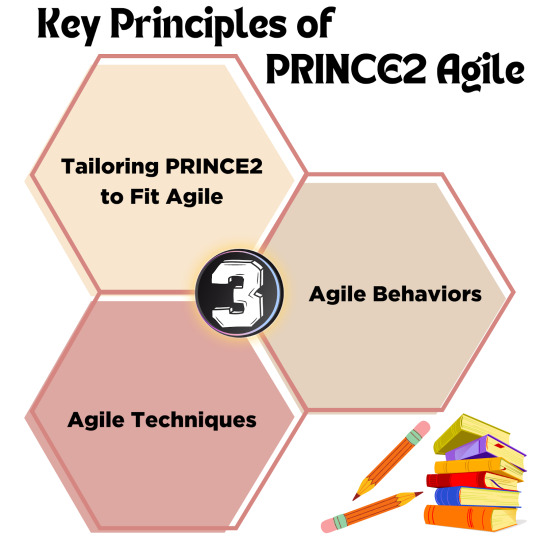
Key Principles of PRINCE2 Agile:
1. Tailoring PRINCE2 to Fit Agile:
PRINCE2 Agile Practitioner allows for tailoring traditional PRINCE2 processes to accommodate Agile practices. This ensures that the methodology is not overly prescriptive, providing room for Agile teams to thrive.
2. Agile Behaviors:
The framework promotes the adoption of key Agile behaviors, such as transparency, collaboration, and frequent feedback. This helps in fostering a culture that values adaptability and embraces change.
3. Agile Techniques:
PRINCE2 Agile Practitioner introduces a range of Agile techniques, including Scrum, Kanban, and Lean Startup, among others. This allows project managers to select the techniques that best suit the project's context and requirements.
Benefits of PRINCE2 Agile Practitioner:
1. Enhanced Flexibility:
The combination of PRINCE2 and Agile provides a structured approach while allowing for flexibility in adapting to changing project dynamics. This ensures that projects can evolve in response to customer needs and market trends.
2. Improved Communication and Collaboration:
The Agile emphasis on communication and collaboration is integrated into PRINCE2 Agile, fostering a more engaged and transparent project environment. This leads to better team cohesion and improved decision-making processes.
3. Reduced Risk:
By incorporating Agile techniques for risk management, such as early and frequent testing, PRINCE2 Agile Practitioner helps identify and mitigate risks proactively. This ultimately minimizes the chances of project failure.
4. Continuous Improvement:
PRINCE2 Agile Practitioner encourages a mindset of continuous improvement through regular retrospectives and feedback loops. This iterative approach ensures that lessons learned are incorporated into future project phases, enhancing overall project performance.
Conclusion:
In the fast-paced world of project management, the PRINCE2 Agile Practitioner approach stands out as a versatile and effective methodology. By combining the best of both PRINCE2 and Agile, this framework empowers project managers to navigate complexity, respond to change, and deliver successful outcomes. As organizations increasingly seek adaptable and responsive project management approaches, the PRINCE2 Agile Practitioner emerges as a valuable tool for achieving project success.
3 notes
·
View notes
Text
Navigating the DevOps Landscape: A Comprehensive Roadmap for Success
Introduction: In the rapidly evolving realm of software development, DevOps stands as a pivotal force reshaping the way teams collaborate, deploy, and manage software. This detailed guide delves into the essence of DevOps, its core principles, and presents a step-by-step roadmap to kickstart your journey towards mastering DevOps methodologies.
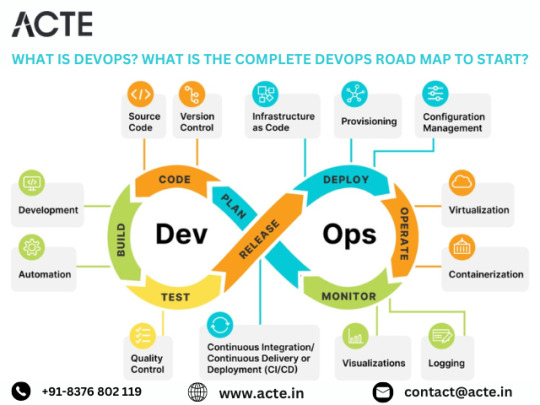
Exploring the Core Tenets of DevOps: DevOps transcends mere toolsets; it embodies a cultural transformation focused on fostering collaboration, automation, and continual enhancement. At its essence, DevOps aims to dismantle barriers between development and operations teams, fostering a culture of shared ownership and continuous improvement.
Grasping Essential Tooling and Technologies: To embark on your DevOps odyssey, familiarizing yourself with the key tools and technologies within the DevOps ecosystem is paramount. From version control systems like Git to continuous integration servers such as Jenkins and containerization platforms like Docker, a diverse array of tools awaits exploration.
Mastery in Automation: Automation serves as the cornerstone of DevOps. By automating routine tasks like code deployment, testing, and infrastructure provisioning, teams can amplify efficiency, minimize errors, and accelerate software delivery. Proficiency in automation tools and scripting languages is imperative for effective DevOps implementation.
Crafting Continuous Integration/Continuous Delivery Pipelines: Continuous Integration (CI) and Continuous Delivery (CD) lie at the heart of DevOps practices. CI/CD pipelines automate the process of integrating code changes, executing tests, and deploying applications, ensuring rapid, reliable, and minimally manual intervention-driven software changes.
Embracing Infrastructure as Code (IaC): Infrastructure as Code (IaC) empowers teams to define and manage infrastructure through code, fostering consistency, scalability, and reproducibility. Treating infrastructure as code enables teams to programmatically provision, configure, and manage infrastructure resources, streamlining deployment workflows.

Fostering Collaboration and Communication: DevOps champions collaboration and communication across development, operations, and other cross-functional teams. By nurturing a culture of shared responsibility, transparency, and feedback, teams can dismantle silos and unite towards common objectives, resulting in accelerated delivery and heightened software quality.
Implementing Monitoring and Feedback Loops: Monitoring and feedback mechanisms are integral facets of DevOps methodologies. Establishing robust monitoring and logging solutions empowers teams to monitor application and infrastructure performance, availability, and security in real-time. Instituting feedback loops enables teams to gather insights and iteratively improve based on user feedback and system metrics.
Embracing Continuous Learning and Growth: DevOps thrives on a culture of continuous learning and improvement. Encouraging experimentation, learning, and knowledge exchange empowers teams to adapt to evolving requirements, technologies, and market dynamics, driving innovation and excellence.
Remaining Current with Industry Dynamics: The DevOps landscape is dynamic, with new tools, technologies, and practices emerging regularly. Staying abreast of industry trends, participating in conferences, webinars, and engaging with the DevOps community are essential for staying ahead. By remaining informed, teams can leverage the latest advancements to enhance their DevOps practices and deliver enhanced value to stakeholders.
Conclusion: DevOps represents a paradigm shift in software development, enabling organizations to achieve greater agility, efficiency, and innovation. By following this comprehensive roadmap and tailoring it to your organization's unique needs, you can embark on a transformative DevOps journey and drive positive change in your software delivery processes.
2 notes
·
View notes
Text
Navigating the Future: Thriving in Automation Testing Careers
In the dynamic landscape of technology, the future of automation testing emerges as a strategic and rewarding career choice, offering enduring prospects and continuous evolution. Here's a deep dive into why automation testing is not just a profession but a journey towards a future filled with opportunities and advancements.

1. Pioneering Technological Evolution: Positioned at the forefront of technological advancements, automation testing serves as a trailblazer, ensuring seamless adaptation to emerging technologies and future innovations.
2. Anchored in Agile and DevOps Realms: The widespread embrace of Agile and DevOps methodologies propels automation testing to the forefront. In an era demanding rapid software releases, automation testing becomes the linchpin for maintaining speed and reliability in development cycles.
3. Surging Demand for Quality Assurance: The escalating complexity of modern software necessitates robust quality assurance processes. Automation testing provides a systematic and efficient approach, meeting the rising demand for top-tier quality in software applications.
4. Efficiency Unleashed: A standout advantage of automation testing lies in its prowess to significantly reduce testing time and costs. Rapid and repetitive execution of automated tests enables efficient bug identification, ensuring swift development cycles.
5. Cross-Industry Versatility: The adaptability of automation testing transcends industry boundaries. Professionals can explore diverse opportunities across sectors like healthcare, finance, e-commerce, and gaming, opening up a spectrum of career avenues beyond conventional limits.
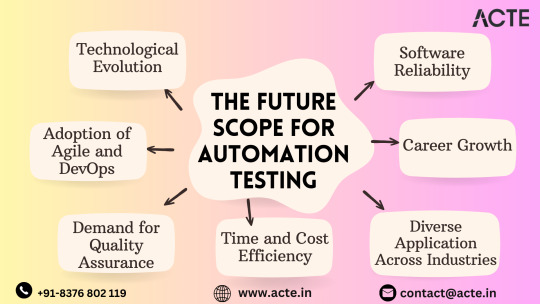
6. Skills Cultivation and Career Ascension: Opting for a career in automation testing provides an enriching environment for skill development. Mastery of automation tools, programming languages, and staying abreast of industry trends pave the way for substantial career growth. Roles such as automation test engineer, test architect, or quality assurance manager showcase the diverse career paths within reach.
7. Fostering Software Reliability: At the core of automation testing is its pivotal role in ensuring the reliability and performance of software applications. Early identification and resolution of issues in the development process contribute to delivering high-quality software products to end-users.
In conclusion, the future of automation testing is a voyage—an exploration of opportunities and advancements. For individuals with a tech-savvy mindset, attention to detail, and a commitment to software quality, choosing a career in automation testing is a forward-thinking and fulfilling decision. As the industry continues to pivot towards automated testing solutions, it remains a field of enduring relevance, promising a future rich with opportunities and impact.
3 notes
·
View notes
Text

By ensuring your software is meticulously tested for global readiness, we help you deliver seamless user experiences across diverse languages and cultures. Let's transform your product into a global phenomenon, reaching audiences far and wide with precision and reliability. https://bit.ly/3EKzvs2 #SDET #GlobalProduct #LanguageGap #SoftwareTesting #UserExperience #Localization SDET Tech
#Software Testing Companies in India#Software Testing Services in India#Test Automation Development Services#Test Automation Services#Performance testing services#Load testing services#Performance and Load Testing Services#Software Performance Testing Services#Functional Testing Services#Globalization Testing services#Globalization Testing Company#Accessibility testing services
Agile Testing Services#Mobile Testing Services#Mobile Apps Testing Services#ecommerce performance testing#ecommerce load testing#load and performance testing services#performance testing solutions#product performance testing#application performance testing services#software testing startups#benefits of load testing#agile performance testing methodology#agile testing solutions#mobile testing challenges#cloud based mobile testing#automated mobile testing#performance engineering & testing services#performance testing company#performance testing company in usa
0 notes
Text
Best Software Development Services in India

Introduction:
Empowering Businesses with the Best Software Development Services in India: Microlent Systems - In the dynamic digital era, businesses across the globe seek to harness the power of software development to propel their growth and success. India, known for its tech-savvy talent and innovation-driven ecosystem, has become a hub for top-notch software development services. Among the frontrunners in this domain, Microlent Systems stands tall as one of the leading software development companies in India. In this blog post, we will explore how Microlent Systems empowers businesses with its exceptional software solutions, driving innovation, and meeting diverse industry needs.
Expertise and Experience:
At the heart of Microlent Systems lies a team of seasoned professionals with extensive expertise in software development. With a deep understanding of various technologies, programming languages, and frameworks, they possess the skills to craft bespoke software solutions for businesses of all sizes and industries. Their wealth of experience ensures that each project is executed seamlessly, meeting deadlines and exceeding expectations.
Comprehensive Software Solutions:
Microlent Systems offers comprehensive software development services that cover the entire spectrum of IT requirements. From web and mobile applications to enterprise solutions, e-commerce platforms, and custom software, the company delivers end-to-end solutions that cater to the unique needs of clients. Their client-focused approach ensures that every software product is aligned with the business goals and objectives of the customer.
Cutting-Edge Technologies:
Staying ahead in the rapidly evolving tech landscape is imperative, and Microlent Systems takes this to heart. The company adopts cutting-edge technologies, best practices, and modern development methodologies to create robust and future-proof software solutions. By leveraging emerging technologies such as Artificial Intelligence, Machine Learning, and IoT, Microlent Systems enables businesses to gain a competitive edge in their respective markets.
Agile Development Methodology:
Agility is at the core of Microlent Systems' software development process. By adhering to agile methodologies, the company ensures that projects are executed in iterative and collaborative cycles. This approach facilitates better communication, flexibility to adapt to changing requirements, and quick delivery of high-quality software solutions.
Client-Centric Approach:
Microlent Systems places the utmost importance on understanding the unique needs of its clients. Their client-centric approach involves active collaboration, thorough requirement analysis, and regular updates throughout the development process. This ensures that the software aligns perfectly with the client's vision and delivers tangible value to their business.
Robust Quality Assurance:
Quality is a non-negotiable aspect of Microlent Systems' software development services. The company employs stringent quality assurance measures, including thorough testing and debugging, to ensure that the software is bug-free, secure, and performs optimally. The dedication to quality results in software solutions that stand the test of time and deliver exceptional user experiences.
Conclusion:
In the bustling landscape of software development services in India, Microlent Systems shines as a beacon of excellence. With its unmatched expertise, comprehensive solutions, cutting-edge technologies, agile methodologies, client-centricity, and robust quality assurance, Microlent Systems stands tall as one of the leading software development companies in India.
For businesses seeking innovative and tailor-made software solutions to drive growth and success, partnering with Microlent Systems is a transformative step towards digital empowerment. Embrace the power of Microlent Systems' software development services to unlock your business's true potential and stay ahead in the ever-competitive digital realm.
#software development#web development#dubai#softwaredevelopment#software development services#affordable software development services#software development company#custom software development#custom software product engineering services company
2 notes
·
View notes
Text
The Role of Software Engineering in Enterprise Architecture - Jegarakshagan Gokul
Jegarakshagan Gokul says, Enterprise architecture (EA) provides organizations with a strategic blueprint for aligning their business processes and IT infrastructure to achieve their goals. It encompasses various domains, including business architecture, data architecture, application architecture, and technology architecture. In this intricate landscape, software engineering plays a pivotal role in implementing and supporting enterprise architecture initiatives. This article explores the critical role of software engineering in enterprise architecture and highlights its impact on organizational success.
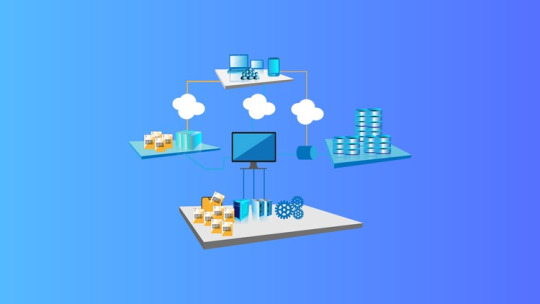
Enabling Alignment and Integration: Software engineering acts as a bridge between enterprise architecture and the actual implementation of systems. It ensures that the software solutions developed align with the architectural principles and strategic goals defined by EA. By incorporating software engineering practices early in the EA process, organizations can achieve seamless alignment and integration across different architectural domains.
Driving Design and Development: Software engineering brings expertise in designing and developing robust, scalable, and maintainable software systems. It plays a key role in translating the architectural blueprints into concrete software solutions. Software engineers leverage their technical skills, knowledge of industry best practices, and adherence to coding standards to build software components that meet the requirements defined by enterprise architects.
Ensuring Quality and Compliance: Software engineering contributes to ensuring the quality and compliance of software systems within the enterprise architecture framework. According to Jegarakshagan Gokul, through rigorous testing, code reviews, and adherence to coding standards, software engineers help identify and rectify issues early in the development lifecycle. This ensures that the software solutions adhere to the architectural guidelines, security protocols, and regulatory compliance requirements.
Supporting Change Management: Enterprise architecture is not static; it evolves over time to meet changing business needs and technological advancements. Software engineering plays a critical role in supporting change management within the EA framework. By following agile methodologies, software engineers can quickly adapt and respond to changing requirements, implement architectural changes, and deliver incremental updates to the software systems.
Enhancing Collaboration: Jegarakshagan Gokul says, collaboration is vital for successful enterprise architecture initiatives. Software engineers work closely with enterprise architects, business stakeholders, and IT teams to understand requirements, address technical challenges, and ensure effective communication throughout the development process. By fostering collaboration, software engineering strengthens the integration of enterprise architecture with business processes and IT systems.
Leveraging Emerging Technologies: Software engineering keeps pace with emerging technologies and trends, allowing organizations to leverage innovations within the enterprise architecture context. Whether it's adopting cloud computing, implementing microservices architecture, or exploring artificial intelligence and machine learning, software engineers play a pivotal role in identifying and integrating these technologies into the enterprise architecture landscape.
Continuous Improvement and Optimization: Enterprise architecture is an ongoing process, and software engineering contributes to continuous improvement and optimization. Software engineers monitor system performance, identify bottlenecks, and implement optimizations to enhance the efficiency and effectiveness of the software solutions within the enterprise architecture. By leveraging feedback and data-driven insights, they drive iterative improvements to align software systems with evolving business needs.
Conclusion: According to Jegarakshagan Gokul, software engineering is not just a technical implementation aspect within enterprise architecture; it plays a vital role in driving successful EA initiatives. By aligning software engineering practices with enterprise architecture principles, organizations can realize the full potential of their architectural investments. The collaboration between software engineers and enterprise architects ensures the design, development, and maintenance of software systems that seamlessly integrate with the overall enterprise architecture, ultimately leading to improved operational efficiency, business agility, and competitive advantage.
2 notes
·
View notes
Text
No Code Test Automation: A Complete Guide for Modern Teams

Introduction to No Code Test Automation
Organizations continuously look for optimized solutions in software testing. Testing processes impact product quality and release speed. Manual testing requires significant effort and technical expertise. Teams now adopt No Code Test Automation as a strategic shift in quality assurance methodology.
No Code Test Automation transforms how businesses approach software testing. ideyaLabs stands out with its advanced no code automation platform. Teams automate complex test cases without writing code. Productivity increases and barriers for non-technical team members reduce.
Understanding No Code Test Automation
No Code Test Automation uses intuitive interfaces and visual workflows. Users build, execute, and maintain tests without scripting. Click, drag, and configure test steps with minimal learning curve. Traditional script-based test automation relies on programming knowledge. No code platforms empower QA specialists, business analysts, and non-developers alike.
Testers use dashboards and built-in libraries to define business rules. Teams focus on test objectives without syntax errors or code hassles. Automation becomes faster and collaboration strengthens among cross-functional groups.
Benefits of Adopting No Code Test Automation
No code frameworks bring immediate benefits:
Reduced dependency on programming skills
Streamlined test design and execution
Accelerated test coverage and regression cycles
Enhanced collaboration across teams
Lower training and maintenance costs
With ideyaLabs’ platform, organizations roll out automation at scale. Testers onboard quickly and leverage reusable components. Frequent product updates and agile environments become manageable.
ideyaLabs: Pioneering No Code Test Automation
ideyaLabs sets benchmarks in innovative automation. The platform delivers simple drag-and-drop workflows. Dynamic data set creation and test parameterization appear seamless. Domain experts automate business-critical processes. Reliability and repeatability become part of every test suite.
Coverage extends to web apps, APIs, and mobile interfaces. Reports transform raw data into actionable insights. Testers diagnose defects in real-time. ideyaLabs integrates with popular CI/CD tools to fit seamlessly into DevOps pipelines.
Core Features that Drive Success
Automation with ideyaLabs opens new possibilities:
Visual test builders: Remove scripting complexity; build tests visually.
Reusable components: Share test modules across multiple scenarios.
Customizable workflows: Adapt automation for unique processes.
Built-in validations: Ensure accuracy and compliance.
Advanced analytics: Monitor test results and application performance.
Collaborative dashboards: Share progress with project stakeholders.
Impact on Business Teams
ideyaLabs empowers non-technical users. Business analysts and product owners design and execute test flows. The distance between business logic and quality assurance disappears. Project managers gain deeper visibility into test progress and issues. Team collaboration strengthens through data-driven decision making.
Time to Market Gets Faster with Automation
Projects face constant deadlines. Reliable, repeatable testing seizes every opportunity for improvement. No Code Test Automation by ideyaLabs reduces test development times. Fast feedback cycles help teams fix defects before production. Continuous testing supports safe and rapid software delivery.
Faster automation improves customer satisfaction through better releases. Every build gets to the market quickly without compromising quality.
How No Code Test Automation Improves Test Coverage
Comprehensive test coverage becomes simple with ideyaLabs. Teams automate repetitive and complex scenarios. Adding regression tests for new features takes less time. Gaps and missed pathways disappear as every rule and workflow receives coverage. Risk of undetected bugs reduces sharply.
No code platforms enable frequent updates and adaptation. The organization stays agile and responsive to market changes.
Maintenance Simplified
Automation solutions often require ongoing code reviews and script maintenance. ideyaLabs removes this burden. Test cases adapt with UI or business logic changes through visual updates. Team members update workflows directly through the user interface. Downtime and errors caused by obsolete scripts become rare.
Seamless Integration with Existing Stacks
Teams avoid disrupting their workflows with ideyaLabs. Integration occurs with popular development and DevOps tools. From issue trackers to deployment solutions, connections remain robust. Automated tests trigger after every code change or deployment.
Analytics plug into reporting solutions. Stakeholders receive clear insights without hours of manual updates.
Security Remains a Priority
No Code Test Automation with ideyaLabs protects organizational data. The platform uses advanced security protocols. Access controls restrict sensitive information. Audit trails and logs create strong compliance records. Testing covers both functionality and security requirements.
Training and Onboarding Made Easy
Training cycles shorten for new QA members. ideyaLabs provides user-friendly modules and documentation. No programming background is required. New team members start productive work quickly after a brief onboarding period.
Scalability for Growing Organizations
ideyaLabs supports scaling from small teams to enterprise environments. The platform handles increased test volumes and complex project needs. Every department maintains individual test suites. Centralized management simplifies oversight. Consistency and quality remain uncompromised.
Conclusion: A New Standard in Test Automation
No Code Test Automation revolutionizes software testing. ideyaLabs drives this transformation with its innovative, user-friendly platform. Organizations boost productivity, accelerate releases, and improve quality. Business and technical teams collaborate closely. Efficient, secure, and adaptable solutions define modern test automation.
Choose ideyaLabs for future-ready test automation—no code required.
0 notes
Text
Software Development Process—Definition, Stages, and Methodologies

In the rapidly evolving digital era, software applications are the backbone of business operations, consumer services, and everyday convenience. Behind every high-performing app or platform lies a structured, strategic, and iterative software development process. This process isn't just about writing code—it's about delivering a solution that meets specific goals and user needs.
This blog explores the definition, key stages, and methodologies used in software development—providing you a clear understanding of how digital solutions are brought to life and why choosing the right software development company matters.
What is the software development process?
The software development process is a series of structured steps followed to design, develop, test, and deploy software applications. It encompasses everything from initial idea brainstorming to final deployment and post-launch maintenance.
It ensures that the software meets user requirements, stays within budget, and is delivered on time while maintaining high quality and performance standards.
Key Stages in the Software Development Process
While models may vary based on methodology, the core stages remain consistent:
1. Requirement Analysis
At this stage, the development team gathers and documents all requirements from stakeholders. It involves understanding:
Business goals
User needs
Functional and non-functional requirements
Technical specifications
Tools such as interviews, surveys, and use-case diagrams help in gathering detailed insights.
2. Planning
Planning is crucial for risk mitigation, cost estimation, and setting timelines. It involves
Project scope definition
Resource allocation
Scheduling deliverables
Risk analysis
A solid plan keeps the team aligned and ensures smooth execution.
3. System Design
Based on requirements and planning, system architects create a blueprint. This includes:
UI/UX design
Database schema
System architecture
APIs and third-party integrations
The design must balance aesthetics, performance, and functionality.
4. Development (Coding)
Now comes the actual building. Developers write the code using chosen technologies and frameworks. This stage may involve:
Front-end and back-end development
API creation
Integration with databases and other systems
Version control tools like Git ensure collaborative and efficient coding.
5. Testing
Testing ensures the software is bug-free and performs well under various scenarios. Types of testing include:
Unit Testing
Integration Testing
System Testing
User Acceptance Testing (UAT)
QA teams identify and document bugs for developers to fix before release.
6. Deployment
Once tested, the software is deployed to a live environment. This may include:
Production server setup
Launch strategy
Initial user onboarding
Deployment tools like Docker or Jenkins automate parts of this stage to ensure smooth releases.
7. Maintenance & Support
After release, developers provide regular updates and bug fixes. This stage includes
Performance monitoring
Addressing security vulnerabilities
Feature upgrades
Ongoing maintenance is essential for long-term user satisfaction.
Popular Software Development Methodologies
The approach you choose significantly impacts how flexible, fast, or structured your development process will be. Here are the leading methodologies used by modern software development companies:
🔹 Waterfall Model
A linear, sequential approach where each phase must be completed before the next begins. Best for:
Projects with clear, fixed requirements
Government or enterprise applications
Pros:
Easy to manage and document
Straightforward for small projects
Cons:
Not flexible for changes
Late testing could delay bug detection
🔹 Agile Methodology
Agile breaks the project into smaller iterations, or sprints, typically 2–4 weeks long. Features are developed incrementally, allowing for flexibility and client feedback.
Pros:
High adaptability to change
Faster delivery of features
Continuous feedback
Cons:
Requires high team collaboration
Difficult to predict final cost and timeline
🔹 Scrum Framework
A subset of Agile, Scrum includes roles like Scrum Master and Product Owner. Work is done in sprint cycles with daily stand-up meetings.
Best For:
Complex, evolving projects
Cross-functional teams
🔹 DevOps
Combines development and operations to automate and integrate the software delivery process. It emphasizes:
Continuous integration
Continuous delivery (CI/CD)
Infrastructure as code
Pros:
Faster time-to-market
Reduced deployment failures
🔹 Lean Development
Lean focuses on minimizing waste while maximizing productivity. Ideal for startups or teams on a tight budget.
Principles include:
Empowering the team
Delivering as fast as possible
Building integrity in
Why Partnering with a Professional Software Development Company Matters
No matter how refined your idea is, turning it into a working software product requires deep expertise. A reliable software development company can guide you through every stage with
Technical expertise: They offer full-stack developers, UI/UX designers, and QA professionals.
Industry knowledge: They understand market trends and can tailor solutions accordingly.
Agility and flexibility: They adapt to changes and deliver incremental value quickly.
Post-deployment support: From performance monitoring to feature updates, support never ends.
Partnering with professionals ensures your software is scalable, secure, and built to last.
Conclusion: Build Smarter with a Strategic Software Development Process
The software development process is a strategic blend of analysis, planning, designing, coding, testing, and deployment. Choosing the right development methodology—and more importantly, the right partner—can make the difference between success and failure.
Whether you're developing a mobile app, enterprise software, or SaaS product, working with a reputed software development company will ensure your vision is executed flawlessly and efficiently.
📞 Ready to build your next software product? Connect with an expert software development company today and turn your idea into an innovation-driven reality!
0 notes